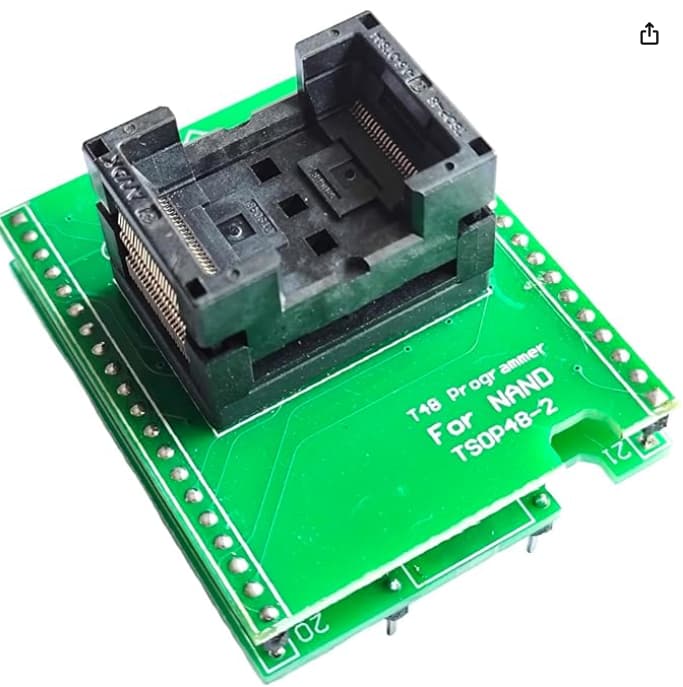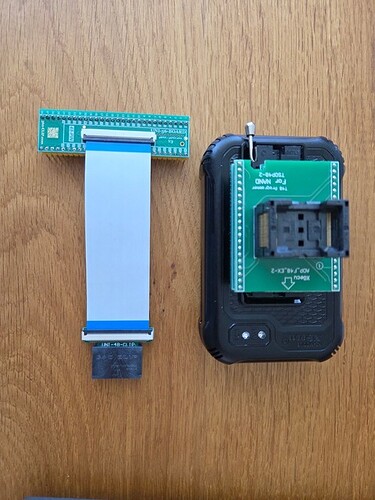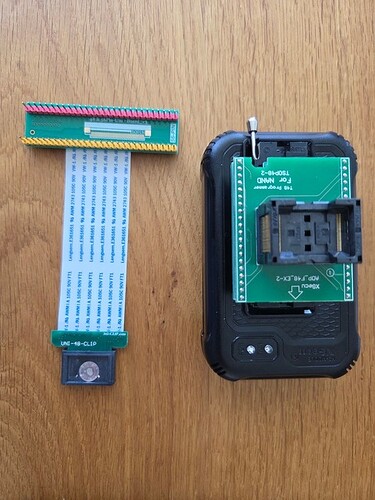Hello!
Glad to see “new” buspirate development. I own 3.6 from years back that still works and have many times helped with debugging and flashing. Must admit i thought BP development was dead and didn’t check Dangerous Prototypes in years.
I wanted to impulse buy BP5 because it looks so cool and is great improvement to 3.6.
But as i currently have problem with one router that uses parallel slc nand, Spansion S34ML01G200TFV0 to be exact, i am wondering if any BP supports this or if support is planned and for which BP version?
I deal mostly with routers and they often come with those type of flash chips in tsop48 package.
Thanks!
Glad you like it!
Can you share the terminal logs?
TSOP48?
The BP5 has eight I/O (+ programmable power, + ground).
Looking at that datasheet on page 10, it looks like there’s seven control lines (CE#, WE#, RE#, ALE, CLE, WP#, R/B#) and up to 16 data lines (I/O0…I/O15).
That’s a lot of control signals, so it would be non-trivial even with a custom plank to get the data. That said, there might be a way to (very slowly) access the data using I/O expanders … but … that would take some serious work.
But, maybe I missed something?
Yeah, a lot of pins. It has 8 and 16 bit mode and 8 data pins should work.
Maybe support in bp 5xl, 6 or 7 then?
I saw couple of project but they are outdated and not beginner friendly as for example:
- NANDWay for Teensy++ 2.0: NORway/NANDway_README.txt at master · hjudges/NORway · GitHub
- DumpFlash for ft2232: GitHub - ohjeongwook/dumpflash: Low-level NAND Flash dump and parsing utility
There is also Pico Flasher for Pi Pico but seems it does not support parallel NAND: GitHub - X360Tools/PicoFlasher
I get it—you’d like a Plank for BP5 and up similar to the classic T48 (XGECU…) programmer adapter for NAND TSOP48, right?
I actually thought about that months ago, but I’m not sure how viable it would be… ![]()
The newer BP models continue to have the same 8 IO pins as the BP 5. It is just that you can do more with them in some applications.
But for your TSSOP48 I guess there is no way around using a bunch of shift registers or other kind of IO expanders.
Or maybe some CPLD or FPGA if speed is important. This model is 3.3V, so you don’t have a problem with finding one that you can directly interface. This would be an issue with any 5V device. But you’d still have to write gateware though.
There is a good reason that the BP just has 8 IO ports. The complexity and costs of the BP would go up a lot. And the number of applications where you really need this are not that many.
I do also own t48 programmer and adapter from the picture but they dont give you pinout to connect bare chip to ziff socket or icsp header with jump wires. I dont want to always desolder tsop48 and use test points on router board or use adapters as 360 clip.
I also found this for STM32F103VCT6, GitHub - bbogush/nand_programmer: NANDO - NAND Open programmer , but again not great support and vibrant community as for BP. And it seems i also have to make pcb on my own.
I see. Well than i guess i would have to search for another tool for parallel nand flashing and use BP for its intended purpose.
I want to thank everybody for such prompt answers.
Desolder a chip and put it in the socket that you can take out without soldering.
Here is a pinout from here.
Your preferred programming method is visa test points on the PCB? Do they provide all of them?
Parallel stuff is tough, it’s just a lot of pins. The PDF linked above shows how the waveforms look. If the chip is 3.3volt tolerant you can use a Raspberry Pi PICO board ($4) to access it directly.
Bus Pirate wise, as @dreg mentioned there could be a bunch of serial to parallel IO expanders (or I2C or whatever). That would be very slow, and probably also a pretty niche bit of hardware?
I have pinout of the chip, but not of the xgecu tsop48 adapter(adp_f48_ex-2).
I want to program the chip onboard using 360 clip + jump wires + “programmer”. Programmer in this example can be anything that supports parallel nand.
360 clip: Original 48pin 56pin 32pin universal 360-clip tsop nand flash für ps3 nand flash 360clip stecker - AliExpress
I guess i will try to trace pins on adp_f48_ex-2 and hook jump wires on the upper board and hope xgecu t48 wont notice it ![]()
Oh wow, I had not seen that type of clip before. That’s really nice.
Are you able to hold the rest of the circuit in reset while you work with the flash? That can be tricky too.
maybe check it if it works. those clips you show are the 360 clips that were used extensively for modding ps3/xbox type stuff. you have two different routes here, you have your in circuit clip to the left and then your xgecu. both different ways of getting at the chip, there are a ton of options out there for programming nand. are you wanting to build or roll your own? in circuit clips for Nand are notorious for instability that is why everyone desolders the chips, puts em in programmers and gets what they want. if your looking at doing magnet wire to Nand stuff check out Colin’s write up Dumping Parallel NAND with Glasgow – Colin O'Flynn
you and I share similar love of the mims then.
so your trying to figure out what pins the xgecu will use in order to attach and read the chip? David Griffith / minipro · GitLab you could just find the chip, read the code and see what it uses for pin vs mapping…though if you have the pin out of the chip no need then you have everything you want to read the Nand.
Thanks for that. Those adapters are really expensive. But it may be a work around my tries to access JTAG on one board and from there the NAND flash. I may just go directly NAND for that target. Also tried XGecku T48 lately with minipro when tried to unbrick UPS. But those bastardos from ATMEL set lock bits and it was a no go. To read you would have to unset lock bits which would erase flash automatically.
here is one last thing I found. https://www.tindie.com/products/1-da/adapter-flashcatusb-xport-360-clip-tsop-48-nand/




